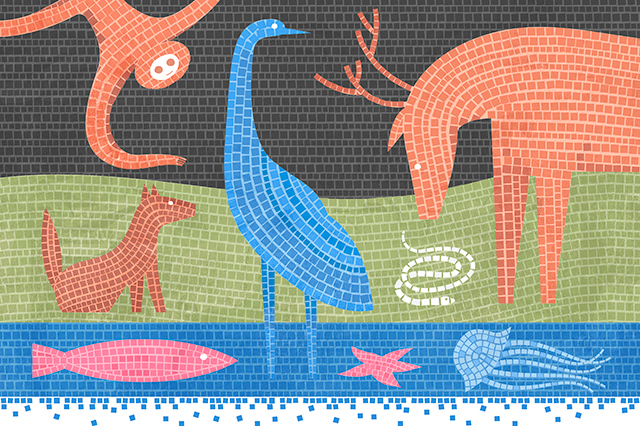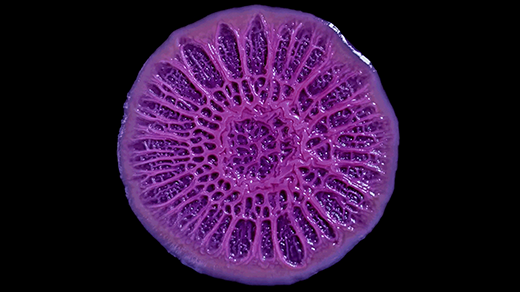Where Animals Come From

For billions of years, single-celled creatures had the planet to themselves, floating through the oceans in solitary bliss. Some microorganisms attempted multicellular arrangements, forming small sheets or filaments of cells. But these ventures hit dead ends. The single cell ruled the earth.
Then, more than 3 billion years after the appearance of microbes, life got more complicated. Cells organized themselves into new three-dimensional structures. They began to divide up the labor of life, so that some tissues were in charge of moving around, while others managed eating and digesting. They developed new ways for cells to communicate and share resources. These complex multicellular creatures were the first animals, and they were a major success. Soon afterward, roughly 540 million years ago, animal life erupted, diversifying into a kaleidoscope of forms in what’s known as the Cambrian explosion. Prototypes for every animal body plan rapidly emerged, from sea snails to starfish, from insects to crustaceans. Every animal that has lived since then has been a variation on one of the themes that emerged during this time.
How did life make this spectacular leap from unicellular simplicity to multicellular complexity? Nicole King has been fascinated by this question since she began her career in biology. Fossils don’t offer a clear answer: Molecular data indicate that the “Urmetazoan,” the ancestor of all animals, first emerged somewhere between 600 and 800 million years ago, but the first unambiguous fossils of animal bodies don’t show up until 580 million years ago. So King turned to choanoflagellates, microscopic aquatic creatures whose body type and genes place them right next to the base of the animal family tree. “Choanoflagellates are to my mind clearly the organism to look at if you’re looking at animal origins,” King said. In these organisms, which can live either as single cells or as multicellular colonies, she has found much of the molecular toolkit necessary to launch animal life. And to her surprise, she found that bacteria may have played a crucial role in ushering in this new era.
In a lengthy paper that will be published in a special volume of Cold Spring Harbor Perspectives in Biology in September, King lays out the case for the influence of bacteria on the development of animal life. For starters, bacteria fed our ancient ancestors, and this likely required those proto-animals to develop systems to recognize the best bacterial prey, and to capture and engulf them. All of these mechanisms were repurposed to suit the multicellular lives of the first animals. King’s review joins a broad wave of research that puts bacteria at the center of the story of animal life. “We were obliged to interact intimately with bacteria 600 million years ago,” said King, now an evolutionary biologist at the University of California, Berkeley, and an investigator with the Howard Hughes Medical Institute. “They were here first, they’re abundant, they’re dominant. In retrospect we should’ve expected this.”
Multicellular Motivation
Although we tend to take the rise of animals for granted, it is reasonable to ask why they ever emerged at all, given the billions of years of success of unicellular organisms. “For the last 3.5 billion years, bacteria have been around and abundant,” said Michael Hadfield, a professor of biology at the University of Hawaii, Manoa. “Animals never showed up until 700 or 800 million years ago.”
The technical demands of multicellularity are significant. Cells that commit to living together need a whole new set of tools. They have to come up with ways of sticking together, communicating, and sharing oxygen and food. They also need a master developmental program, a way to direct specific cells to take on specialized jobs in different parts of the body.
Nonetheless, during the course of evolution, the transition to multicellularity happened separately as many as 20 different times in lineages from algae to plants to fungi. But animals were the first to develop complex bodies, emerging as the most dramatic example of early multicellular success.
To understand why this might have happened the way it did, King began studying choanoflagellates, the closest living relative to animals, nearly 15 years ago as a postdoc at the University of Wisconsin, Madison. Choanoflagellates are not the most charismatic of creatures, consisting of an oval blob equipped with a single taillike flagellum that propels the organism through the water and also allows it to eat. The tail, thrashing back and forth, drives a current across a rigid, collarlike fringe of thin strands of cell membrane. Bacteria get caught up in the current and stick to the collar, and the choano engulfs them.
What intrigued King about choanoflagellates was their lifestyle flexibility. While many live as single cells, some can also form small multicellular colonies. In the species Salpingoeca rosetta, which lives in coastal estuaries, the cell prepares to divide but stops short of splitting apart, leaving two daughter cells connected by a thin filament. The process repeats, creating rosettes or spheres containing as many as 50 cells in the lab. If this all sounds familiar, there’s a reason for it — animal embryos develop from zygotes in much the same way, and spherical choanoflagellate colonies look uncannily like early-stage animal embryos.
When King began studying S. rosetta, she couldn’t get the cells to consistently form colonies in the lab. But in 2006, a student stumbled on a solution. In preparation for genome sequencing, he doused a culture with antibiotics, and it suddenly bloomed into copious rosettes. When bacteria that had been collected along with the original specimen were added back into a lab culture of single choanoflagellates, they too formed colonies. The likely explanation for this phenomenon is that the student’s antibiotic treatment inadvertently killed off one species of bacteria, allowing another that competes with it to rebound. The trigger for colony formation was a compound produced by a previously unknown species of Algoriphagus bacteria that S. rosetta eats.
S. rosetta seems to interpret the compound as an indication that conditions are favorable for group living. King hypothesizes that something similar could have happened more than 600 million years ago, when the last common ancestor of all animals started its fateful journey toward multicellularity. “My suspicion is that the progenitors of animals were able to become multicellular, but could switch back and forth based on environmental conditions,” King said. Later, multicellularity became fixed in the genes as a developmental program.
King’s persistence in studying this humble organism, which was overlooked by most contemporary biologists, has won her the admiration of many of her fellow scientists (as well as a prestigious MacArthur fellowship). “She strategically picked an organism to gain insight into early animal evolution and systematically studied it,” said Dianne Newman, a biologist at the California Institute of Technology in Pasadena, who studies how bacteria coevolve with their environment. King’s research offers a thrilling glimpse into the past, a rare window into what might have been going on during that mysterious period before the first fossilized animals appeared. The research is a “beautiful example” of how bacteria shape even the simplest forms of complex life, Newman said. “It reminds us that even at that level of animal development, you can expect triggers from the microbial world.” The bacteria system in S. rosetta can now be used to answer more specific questions, such as what the benefit of multicellularity might be — a question King and her collaborators at Berkeley are now working to answer.
Of course, just because bacteria trigger modern choanoflagellates into group living, that doesn’t mean they had the same effect on the first proto-animals. King’s finding is “really cool,” said William Ratcliff, a biologist at the Georgia Institute of Technology in Atlanta who experimentally induces yeast to form multicellular colonies. “I think she’s doing some of the most interesting research in the origins of animals.” But, he cautions, it’s possible that choanoflagellates evolved this mechanism long after they diverged from the creatures that became the first ancestors of animals. “We don’t have a clear picture of when the bacterial response evolved,” he explained. “It’s hard to know if something happened before the split between choanoflagellates and animals, or after.”
“I think there is enough evidence to allow us to hypothesize that bacteria were an important influence on animal origins — they were abundant, diverse, and they exert important signaling influences on diverse animal lineages as well as on non-animals,” King said. “But I think it is premature to say what the nature of that influence was.”
One strong hint that bacteria may have prompted that ancient transition to multicellularity is that many of today’s simplest animals are governed by microbial messages. Corals, sea squirts, sponges and tube worms all begin life as larvae floating in the water, and other research teams have shown that they too respond to compounds released by bacteria as signals to attach themselves to rocks or other surfaces and transition to a new life form. If this kind of relationship is so common among animals from the most ancient families, it seems plausible that the first animals were equally attuned to their bacterial neighbors. Figuring out how, exactly, the bacteria trigger this response will help clarify whether they played a similar role long ago. “It was a radical thought to me when we first started studying it, and now I don’t know why it’s a surprise,” King said. “The more I think about host-microbe interactions, the less surprised I become.”
The biology of choanoflagellates resembles that of animals in other unexpected ways, King found. In 2008 she led the team that published the genome of Monosiga brevicollis, a choanoflagellate that doesn’t form colonies. The sequence revealed genes for dozens of sections of proteins that also appear in multicellular animals, where they help cells stick together and also guide development and differentiation. What are they doing in single cells? King’s work suggests they arose in single-celled organisms to monitor environmental conditions and recognize other cells such as bacterial prey. In multicellular animals, the gene domains found new purposes, such as allowing cells to signal one another. Single cells used these tools to listen in on the environment. Later on, the first cells to adopt a multicellular lifestyle probably repurposed the same systems to pay attention to their sister cells, King suggested.
What Took Animals So Long?
What triggered the explosion of complex multicellular life in the Cambrian period? Increased oxygen undoubtedly had something to do with it — prior to a period sometime before 800 million years ago, atmospheric oxygen levels were too low to diffuse easily into organisms with multiple layers of cells, limiting the size of all life forms. But an increase in oxygen is probably not the whole story, said Andrew Knoll, a professor of earth and planetary sciences at Harvard University. Once oxygen levels rose past this low level, predation likely provided a strong incentive for animals to get bigger and more complicated, and to develop new body plans. It was an ecological arms race of size and complexity: Bigger predators have an advantage in catching prey, while larger prey can more easily avoid being eaten. The need to escape or repel predators also likely inspired the first scales, spines and body armor, as well as some of the wilder body plans seen in Cambrian fossils.
King’s discovery about choanoflagellates is just one of the latest insights into the intimate relationships between bacteria and animals (or, in this case, animal-like organisms). Historically, photosynthetic bacteria pumped oxygen into the oceans for billions of years, setting the stage for complex multicellular life. And according to the endosymbiotic theory, proposed in the 20th century and now widely accepted, the mitochondria inside every eukaryotic cell were once free-living bacteria. At some point more than a billion years ago, they took up residence inside other cells in a symbiotic relationship that endures in nearly every animal cell to this day. In their role as dinner, bacteria also likely provided raw genetic material for the first animals, which probably incorporated chunks of microbial DNA directly into their own genomes as they digested their meals.
But the full story of the microbial-animal relationship is even broader and deeper, argues Margaret McFall-Ngai, a biologist at the University of Wisconsin, Madison, and it’s a story that is only beginning to be told. In her view, animals should rightly be considered host-microbe ecosystems. Several years ago McFall-Ngai, along with Hadfield, convened a broad group of developmental biologists, ecologists, environmental biologists and physiologists, including King, and asked them to formulate a microbial manifesto — a declaration of bacterial significance. The paper, which appeared late last year in the Proceedings of the National Academy of Sciences, cites evidence from many corners of biology to argue that the influence of microbes on the origin, evolution and function of animals is pervasive and essential to understanding how animal life evolved. “They evolved in a world saturated with bacteria,” Hadfield said.
The breadth and significance of the animal-bacteria relationship goes far beyond the development of a handful of ancient aquatic creatures like sponges. McFall-Ngai’s own research shows that bacteria are necessary for the development of organs in squid; others have found similar partnerships that shape the maturation of animal immune systems, the guts of zebra fish and mice, and even mammalian brains. Likewise, bacteria are essential partners in the digestive systems of creatures ranging from termites to humans. The influence of microbes is even inscribed on our genome: More than a third of human genes have their origins in bacteria. These and other new findings will soon fundamentally alter our understanding of life, McFall-Ngai predicts: “Biology is in a revolution.”
So in the end, maybe animals really aren’t all that special. After all, they’d be nothing without their microbial friends. And as King’s research has revealed, much of what animals do that seems to make them interesting can also be accomplished by choanoflagellates. To her, that doesn’t diminish either one. “I love choanoflagellates,” she said. “They’re so fascinating. I see that they’re doing a lot of the same things as animals, and I can see parallels between their biology and the cell biology of animals. I could watch them for hours.”
Corrected on July 29, 2014: An earlier version of this article incorrectly stated that “Animals never showed up until 700,000 or 800,000 years ago.” The correct figure is 700 to 800 million years ago.
This article was reprinted on Wired.com.



